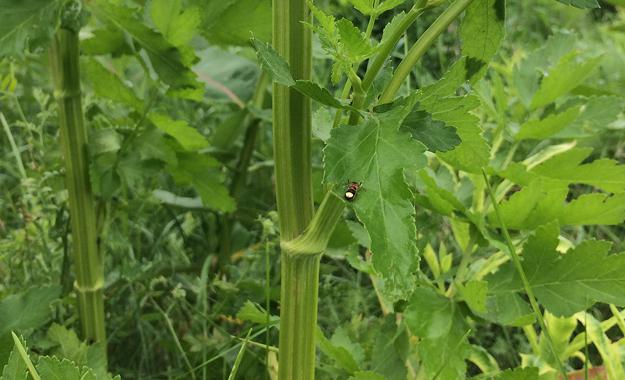Stewardship Tip: Persistence and Patience Needed to Control the Pesky Parsnip

Story by Ellen Snyder, Ibis Wildlife Consulting.
For the past three summers, Vermont consultant Mike Bald (GotWeeds?) and I have pulled thousands of stems of wild parsnip in a field at the Oyster River Forest conservation area in Durham. Although not on New Hampshire’s invasive plant list, wild parsnip produces a sap that can cause burns to the skin in the presence of sunlight. In some cases, the burns are similar to second-degree sunburns, and can cause painful rashes and blisters. The good news is that parsnip sap is unlike poison ivy, which is an oil, so it won’t linger on clothes, pets, or equipment.
Native to Eurasia, wild parsnip-- Pastinaca sativa--has a long taproot and was the original source of parsnip cultivars grown in gardens. It escaped cultivation in the United States and is now widespread in some places. Here in New Hampshire we are working to document its presence and curb its spread. If you find wild parsnip in New Hampshire, you can post the location using a phone app (GLEDN) or on your home computer at Early Detection & Distribution Mapping System or EDDMapS.
Wild parsnip is a biennial. The first year it develops a rosette of low growing leaves that resemble large celery tops. In year two it sprouts a hollow, grooved flower stalk that grows 2-5 feet or more. By mid-summer the branched stalk bears umbels of small yellow flowers that produce many large, flat, oval seeds before the entire stalk turns brown in late summer.
Our parsnip control focuses on second year stalks when they are still in flower, beginning in July. It takes some practice to develop a search image for the parsnip. The parsnip’s yellow flowers often blend in with other flowering plants, especially under bright sunlight. Wild parsnip grows in roadsides, meadows, and field edges, among goldenrods, tall grasses, shrubs, grape vines, and other plants.
Since parsnip has a caustic sap and grows among dense vegetation waist high or higher, it takes careful measures to remove each plant. We dress in pants, long-sleeved shirt, rubber boots, long kitchen gloves, hat, and glasses—all better to protect skin from contact with parsnip sap and other potential hazards: poison ivy, ticks, hornet nests, and thorny bushes. Besides the myriad skin hazards, one might encounter woodchuck holes, extreme heat, barbed wire, and other tripping hazards. We carry our gear—water, snacks, lunch, flagging, Technu, towel, notebook—in five gallon buckets. Other tools include a potato fork or narrow shovel for prying out tough taproots. Each parsnip is carefully and slowly pulled out of the ground. Flowering parsnip, once pulled, will still develop seed, so all pulled plants must be piled in just a few places to avoid seed spread.
During the month of July I was back in the field at the Oyster River Forest pulling parsnip. In collaboration with Nature Groupie, we hosted a wild parsnip training at the Oyster River Forest. The advanced training provided an opportunity for participants to learn stewardship techniques in identifying wild parsnip and steps required to (safely) pull, handle, and dispose of the material on site. The 1-minute video at the top of this post gives you a look inside the training.
The "Parsnip Predator," a tool used at the advanced training, is available to borrow from the Stewardship Tool Library in Epping, New Hampshire.
In the meantime, keep an eye out for wild parsnip, especially here in New Hampshire, where we are still in ‘early detection’ mode. It's easy to report wild parsnip that you find on EDDMapS using this 2-page fact sheet from UNH Extension/Nature Groupie as a guide:
Mike Bald advocates vigilance, persistence, patience, education, respect, cooperation, and humility when working with invasive plants. He is now into years 4, 5, and 6 pulling parsnip on some sites in Vermont. The plants are much fewer, but those remaining are shorter—harder to detect below surrounding vegetation—and flowering later in the growing season, up to first frost. “These invasive plant populations are dynamic and responsive, and with the land itself constantly in seasonal and long-term transition, the management challenge is quite real,” says Mike. We are pursuing wild parsnip at the Oyster River Forest with Mike’s sage advice in mind.


